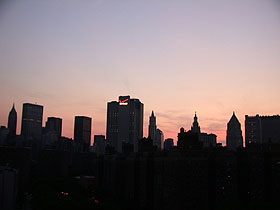 |
| Blackout left New York skyscrapers dark at sundown. (Photo by Tom Sawyer for ENR) |
The eastern half of the U.S. and Canada scrambled to repower August 15, the day after the largest blackout in North American history left approximately 50 million people in the dark.
Officials are investigating the cause of the outage, but the North American Electric Reliability Council was looking a "nine second event" in the Lake Erie Loop, where American Electric Power and First Energy systems meet. A spokesman from NERC, a Princeton, N.J.-based electric utility association, said that at 4:11 p.m. Eastern Standard Time a "nine-second event" caused 300 Mw moving from west to east on the grid to suddenly reverse direction, sending the power from east to west. Within a minute, powerplants in Pennsylvania, Michigan and New York shut down. The event quickly expanded and within 90 seconds power was lost from Ontario and Quebec in Canada south through Massachusetts, Connecticut. New York City to northern New Jersey and west to the Great Lakes states of Ohio and Michigan. In all 61,800 Mw of customer load went down, according to NERC.
The other major U.S. power grids-centered in Texas and west of the Mississippi-escaped unscathed, as did the southern portion of the Eastern grid. By midday Friday approximately 90% of the power had been restored, although Detroit Edison warned that some its customers may not be back online before Sunday evening.
President Bush called the blackout "a wake-up call." He said the event underscored the poor condition of the transmission system. "We need need to build more redundancy into our system," he said.
"It's absurd that it takes this kind of blackout to focus on the inadequacy of our national power grid," said Kyle McSlarrow, deputy secretary of energy. Other electric power experts were quick to place blame on recent trends in energy deregulation. Utilities earn more profit from building power production, not transmission lines, one said.
As power began to return, the massive outage sparked a congressional investigation into what happened. It also may give a push on Capitol Hill to omnibus energy legislation, or a narrower bill focusing just on ensuring reliability of the electricity network.
House Energy and Commerce Committee Chairman W.J. "Billy" Tauzin (R-La.) said on Aug. 15 that his panel would begin investigating the blackout, and would hold a hearing soon after Congress returns from its August recess. Tauzin also said the blackouts showed the need to pass energy legislation. A House and Senate conference committee will begin meeting in September to reconcile differences between the energy bills that passed each chamber. Tauzin said his goal is to have energy legislation to the White House by Thanksgiving.
But the committee's top Democrat, John Dingell of Michigan, said Congress may need instead to pass a separate electric power reliability measure. He said, "We may need to put targeted reliability legislation on the fast track, and not let it get bogged down in the broader energy bill now going to conference."
Tauzin said, "While deeply troubling, it is not especially surprising to me that there has been a failure of a major North American power grid."
Industry observers long have warned that the transmission system is inadequate to the demands being made on it. In the past quarter-century, demand has grown in tandem with the expanding economy. Until 1998, concern centered on the generation shortfall. A boom in generation began that year and petered out in 2002, leaving a supply that most consider adequate. But stubborn resistance has met almost every attempt to add to the transmission system. New Mexico Gov. Bill Richardson (D), who served as energy secretary in the Clinton administration, told a television interviewer Aug. 14, "We are a superpower with a Third-World grid. Our system is very antiquated. We do not have enough transmission. Nobody has been building enough transmission. We've got to build more transmission lines or...we're going to have more blackouts."
Relief may be slow in coming. "It takes seven years to permit and build a new transmission line," said a spokeswoman for the California Independent power system.
The Cross-Sound Cable from Connecticut to Long Island is an example of the difficulties encountered in building new transmission lines. It was laid on schedule in summer 2002, but the state of Connecticut succeeded in preventing it from being energized by objecting that it had not been buried as deeply as required in the permits. Today, New York Gov. George E. Pataki (R) asked the Dept. of Energy to order it energized so its 330 Mw capacity could be used to meet demand on the transmission-constrained New York island.
The Dept. of Energy has told the New York and New England Independent System Operators to activate the 330-megawatt power cable across the Long Island Sound, if necessary. The cable runs from Shoreham, N.Y., to New Haven. Declaring that an emergency exists, DOE Secretary Spencer Abraham issued the directive late on Aug. 14 to permit power to be carried between the states in either direction. The order is effective until Sept. 1, unless changed as developments warrant, DOE says.
In New York City, many people felt a nervous sense of déjà vu, as shop lights and traffic signals failed and sirens pierced through the city's normal weekday din. Mayor Mike Bloomberg (R) quickly took to the airwaves to reassure citizens that the blackout was not a result of a terrorist act. Idle commuter train and subway system lines flushed tens of thousands of people into the Manhattan streets, as people sought alternate means of getting home. Buses were jammed. Many taxi drivers were reaping windfall profits; one man paid $100 for a ride from midtown to Northern Manhattan. The seven-mile run normally costs about $12. Bridges over the East River were jammed with pedestrians. Bodega owners on the other hand for the most part performed admirably, admitting customers into their darkened shops two and three at a time. "I couldn't believe it--they only charged me list price," said one man carrying two gallons of bottled water and a package of batteries.
 |
| With no subway or commuter train service available, New Yorkers took to the streets. (Photo by Tom Sawyer for ENR) |
The New York City Dept. of Environmental Protection asked people not to open fire hydrants, since demand had left water pressure dangerously low. The overnight number of emergency response calls was about 48,000, a record. Unlike the 1965 and 1975 blackout, looting was confined to a shoe store and cell phone center in Brooklyn.
By Friday afternoon, DTE Energy, parent company of local supplier Detroit Edison, had restored 16% of load power to 300,000 combined residential and commercial customers, out of 2.1 million total in its reach. Officials indicate that Detroit Edison had brought online 4 out of its 25 distributed generation units and now is supplying 1,500 MW of power to the metropolitan area. Normal loads this time of year typically average 11,000 MW of continuous electricity through Detroit Edison's system, says Amy Allor, DTE Energy spokeswoman.
"We are targeting to have a total of 14 generating units online today," says Allor. As to the cause of the blackout, Allor says engineers are still analyzing data while they slowly restart generators throughout the day. "From our system, it appears that it came from Ontario," she says.
Cleveland has restored approximately 90% of power but is coordinating with supplier First Energy Corp. one to four-hour rolling blackouts throughout the day and evening, affecting hundreds of thousands of residential and commercial customers.
Water treatment also was knocked out at all four of the city's large water pumping stations. Cleveland's water division initiated a boil order early this morning. City officials expect it to continue throughout the day.
"We are still looking into what may have caused the blackout," says Shelley Shockley, spokeswoman for Cleveland Public Power. Shockley speculates that Ohio's electrical system was a possible source, but details were still unclear.
In other developments, the Nuclear Regulatory Commission said it is monitoring the nine nuclear plants that were shut during the afternoon of Aug. 14 as the power outages occurred. The NRC said, "All the plants are in a stable, safe condition." The NRC said when the electricity grid is lost, protective circuits of the nuclear reactors and turbine generators automatically shut the plan to protect the equipment.
The affected nuclear plants are FitzPatrick, Ginna, Indian Point units 2 and 3 and Nine Mile Point units 1 and two in New York; Oyster Creek in New Jersey; Perry in Ohio; and Fermi in Michigan. NRC said the Davis Besse plant in Ohio also lost off-site power but had been shut down already.
NRC also noted that the plants have backup power systems, usually diesel generators, to keep safety systems running.
Energy Secretary Spencer Abraham said that utility workers in the region were restoring service and trying to determine the cause of the problem. He also urged the public in the areas to conserve power, saying, "Consumers should unplug major appliances until stable power is restored."
And reports from a couple of utilities:
The Long Island Power Authority reported that as of 8:30 a.m. Aug. 15, about 888.000 customers had power restored of 1.1 million who lost service in the blackout. LIPA also said it was activating conservation programs for residential and business customers.
In Ohio, FirstEnergy Corp., Akron, said it had initiated rolling power reductions in areas around Cleveland. Circuits would be out of service for about two hours, it said, which would affect about 125,000 customers temporarily.
|


Post a comment to this article
Report Abusive Comment